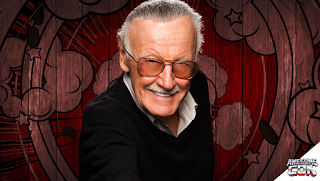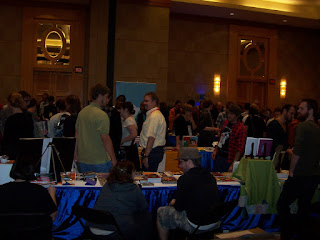by Mike Rhode and Chris Ingram
Heroic Aleworks, a brewery with comic book-themed beers, opened in Woodbridge, VA this past January. We recently met Kate Hoke, co-founder and co-owner of the brewery, and interviewed her on comics, cosplay and beer making.
What type of comic work or cartooning do you do?
I wrote the first issue of our comic, which tells the Solasta origin story, and will be doing the bulk of the writing going forward. Fortunately, we have professional artists to handle the drawing part! For each one of the beers my husband, Tim Hoke, and I create all the characters in terms of deciding who’s a bad guy and who’s a good guy, what are their powers, where to they fit in our comic universe, their name, and basically what they look like. Then I put together a Pinterest board for the artist to give them examples for hairstyles, armor, weapons, poses, backgrounds, etc., that get turned into the final work. Although we have only one issue right now, each and every one of our beer characters fits into the larger universe we’re creating and will all play some role in the ongoing stories.
I also do all of the graphic design work and web design for Heroic.
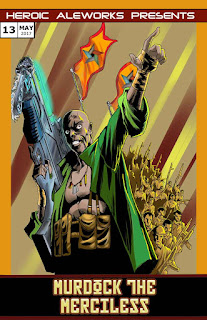 How do you do it? Traditional pen and ink, computer or a combination?
How do you do it? Traditional pen and ink, computer or a combination?Haha. I pay people! But the artists we work with use a combination of traditional pen and ink, along with digital rendering. The artists who created the characters for Sid Fist and Murdock the Merciless (Raymond Francis and Robert Spencer), for example, start with traditional pencil and paper and once the sketch is complete they do a high resolution scan and finish the piece digitally. Our first comic was done entirely digitally. My impression, however, is that most of our art is created through a combination of the two.
How did you find your artist's stable? Who are the people in it?
We work with artists literally from all over the world, many of whom I met through artist commission websites. We also have a few local artists that we met at comic conventions, and I’m hoping that number will increase over time. Here’s a breakdown of everyone so far, their website or Facebook page, and what characters they’ve done for us:
Ian Richardson (Great Britain)
o http://pencilsandstrings.deviantart.com/
o Solasta, Max Nix, Doctor Enigma, Mind Trappe, Death Blossom, the 63 Scottish Fold Oracle, and our logos

They Did This! - Illustration and Design (South Africa)
o Primary artists are Karl Mostert and Andrew Cramer
o https://www.facebook.com/TheyDidThisStudio/
o Mistress of War, Master Heist, Oda the Huntress, Krystal Palast, Goldfang (coming soon), Confounded IPA (Moray Rhoda, artist)
Keith Hinman (Michigan)
o http://kwh-illustration.deviantart.com/
o The Dark Enemy, Baron von Blackbrane
Raymond Francis (local)
o https://www.facebook.com/C3Comics/
o Sid Fist
Robert Spencer (local)
o https://www.facebook.com/C3Comics/
o Murdock the Merciless
Zachary Davis Bradley (New Mexico)
o http://zachdb.deviantart.com/
o Heroic Aleworks Presents Issue #1 sequential art
 | |
| Tim Hoke |
Tim and I were both born in the 1970s. I was born in Philadelphia and he’s from Southern Illinois. We met during our first year of law school in Northern Illinois and soon thereafter the army brought us to Virginia.
Why are you in Washington now? What neighborhood or area do you live in?
I went to law school at William & Mary in Williamsburg, VA, but came up here after graduation because this is where most of the good jobs are. We currently live in Woodbridge, which is why we opened the brewery in Woodbridge. But Tim & I still have to commute to our day jobs in Washington, DC at least 3 days a week.
What is your training and/or education in cartooning?
Zero. I just read a lot. When I’m reading more, I find that I have better ideas for writing the comics.
Even for the graphic and web design, I’m entirely self-taught. Mostly a whole lot of online tutorials and YouTube videos.
Who are your influences?
One of my biggest influences is Neil Gaiman. As we start publishing our books, you’ll see a lot of Gaiman-esque magical realms hidden within our own, but not visible or accessible to most folks. We will also be having a whole “Old Gods” line of beers, which is obviously a Gaiman influence. I love the way he tells stories such that the reader shifts seamlessly between fantasy and reality and is left wondering if there’s even a difference.
In terms of comic book authors, Kelly Sue DeConnick has had a huge influence on me due to her masterful handling of strong female characters that retain their humanity and even femininity. We’ve been quite deliberate about how we conceptualize and portray our female characters, and I aspire to bring some Kelly Sue sensibility to our stories.
If you could, what in your career would you do-over or change?
I often like to believe that I would have preferred to pursue a career in the arts at an early age. But honestly I can’t say that there’s much I’d actually like to change since that would mean I wouldn’t be here doing this right now. That said, there are probably a million small things we would have done differently in how we approached opening a brewery! Lots and lots of lessons learned there! The good news is that we’ll take all of that knowledge into the next phase when we’re ready to expand.
 | |
| Kate Hoke at Baltimore Comic Con 2016 |
So to spin off in a completely different direction… I’m probably best known in the local cosplay scene for my Winter Soldier costume. I was doing it before it became super popular AND when I decided to do a female version of him, I wanted to honor the essence of character and not just slut it up like lots of ladies do with their gender bending cosplays. I’ve been told that keeping Bucky a total badass is part of what makes it sexy, more so than when people just expose as much skin as possible with their costumes.
What work are you most proud of?
That’s a tough one, so I’ll answer it in a couple of ways. I’m immensely proud that we actually pulled off the whole brewery in the way that we did. In particular, I’m proud of the taproom. I did all the painting, made the restroom doors (the Tardis door and the entrance to the Mines of Moria from Lord of the Rings, a.k.a. the Doors of Durin), did all of the decoupage work for the bar, and did all the decorating. I even made one of the pieces of art that hangs on the wall! Suffice it to say it was a very busy December last year! The taproom décor sets the tone and makes our place unique among craft breweries, so it’s been a very significant accomplishment for me.
On a solely personal level, I’m quite proud of the leatherwork I did for my latest cosplay. I’m completely self-taught and I recently created a Viking warrior version of the traditional Slave Leia costume that required intricate weaving and carving like I’ve never done before. And not only does it look amazing, but it’s actually comfortable to wear, which definitely isn’t always the case with cosplay! This one laid the foundation for some crazy stuff I have planned for next year for Tim & me. Next level stuff, for sure.
What would you like to do or work on in the future?
First and foremost I’d like the brewery to be successful enough that Tim & I can quit our day jobs and run the brewery full time. In my case, that would mean a lot more comic writing, more time for planning and promoting events, and a whole lot more time for making costumes.
What do you do when you're in a rut or have writer's block?
Have another glass of wine! Just kidding. Sort of. More helpful, though, is switching back and forth between my various creative endeavors. If I get stuck for words, I’ll turn to doing something visual and vice versa. Beyond that, if I get in a slump doing graphic art on the computer, I find that making physical art, such as my leatherwork, can give me the space to recharge my brain. Sometimes I simply talk it out with my husband and he’ll see an angle I hadn’t previously considered that gets me back on track.
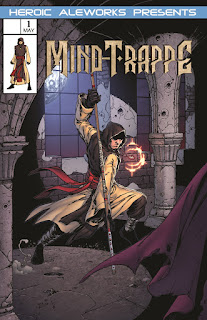 What do you think will be the future of your field?
What do you think will be the future of your field?Geek culture is certainly experiencing a golden age right now with the proliferation of comic-based movies and television shows and surging popularity of comic/pop culture conventions. Even if this moment passes, I believe good storytelling will always find an audience. Creating a narrative and having a story behind each of our beers gives our customers a little something extra to relate to and I think that will hold true even if comics fall out of mainstream culture.
And even if the growth of craft beer levels off, the market for great beers and solid brands isn’t going anywhere.
The fact that Heroic is an intersection of the two gives us some very unique opportunities so I think we have a lot of exciting things ahead of us.
What local cons do you attend? The Small Press Expo, Intervention, or others? Any comments about attending them?
We have traditionally attended Awesome Con and Baltimore Comic Con, both of which are great for cosplay and for networking, but less so for actually collecting comics these days. We’ve noticed prices going up significantly, with vendors asking way more for books at the show than they sell for on eBay. For serious comic collecting, I tend to prefer smaller affairs where there’s more opportunity to browse and have conversations with the vendors. This year will be special because it’s the first time Heroic will have booths at both Awesome Con and the new NOVA CON. We’ll still be attending Baltimore, but as civilians. I’ve promised Tim that we’ll have at least half a day at each where I’m not in costume so we can enjoy our time together instead of getting continuously interrupted for photos.
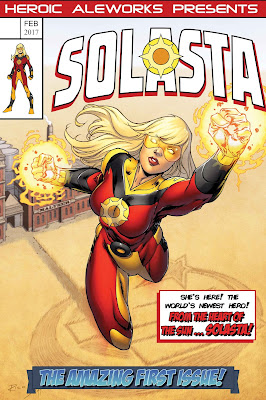 How do I get the first issue of Heroic Aleworks Presents: Solasta? I can't see any way to buy it on your website.
How do I get the first issue of Heroic Aleworks Presents: Solasta? I can't see any way to buy it on your website.We'll have them for sale at Awesome Con
What's your favorite thing about DC?
With the Kennedy Center and so many other theaters around, there’s never a lack of live entertainment options.
Least favorite?
It’s a close tie between the traffic and how politics seeps its way into everything.
What monument or museum do you like to take visitors to?
Who has time for that sort of thing? We used to enjoy the National Zoo a lot and wish we could get there more. I’ve also always wanted to do a tour of the Masonic Temple in Alexandria.
How about a favorite local restaurant?
Cock and Bowl in Occoquan has been a go-to of ours for a long time. Their croque monsieur is amazing and they an extensive and interesting beer selection. The brunch at FireFlies in Del Ray is also at the top of the list.
Do you have a website or blog?
The brewery’s website is www.heroicaleworks.com. We’re also on Facebook (@HeroicAle) and Instagram (@HeroicAleworks). I also have a separate Instagram page for my cosplay work @kateskostumes, which I have been shamefully neglecting as of late.
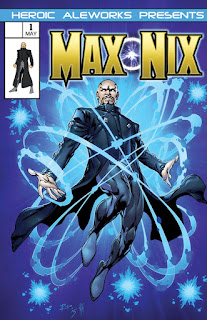 You currently have 9 or so beers on tap - which are your flagship brews and which are your seasonal brews?
You currently have 9 or so beers on tap - which are your flagship brews and which are your seasonal brews?Our flagship brews are the 5 we started with, the Doctor Enigma IPA, the Max Nix English Porter, the Solasta Kolsch, the Death Blossom Red Rye Ale, and the Mind Trappe Belgian Dubbel. Together these 5 characters form our core team of heroes named “The Superhuman Syndicate.” The rest of our beers are seasonals or special releases.
Is there any particular style of beer that you would consider to be your most outstanding?
Our Max Nix just took a gold medal at the Virginia Craft Brewer’s Guild Beer Cup, so we’re feeling kind of partial to that one right now! But the award bears out the feedback we’ve received, not only from our customers but also from other professional brewers, regarding the quality of this beer.
 | |
| Brewmaster Leon Harris |
Our Head Brewer, Leon Harris, is most proud of his Maibock. This recipe was the first one of his beers to get produced commercially. Back when he originated the recipe at Capitol City Brewing Company, the beer was named “Murdock’s Maibock.” Murdock is Leon’s son. So when we did the recipe at our place, we wanted to keep “Murdock,” but to put the Heroic spin on it, Leon and I worked together to create the “Murdock the Merciless” character.
Which beer is your most popular (or top seller, if that's the correct way to think of it)?
We’ve been tracking this pretty closely and all of our flagship beers sell pretty evenly across the board. Murdock has been one of our top selling seasonal beers so far. But nothing has rivaled the popularity of our 63 Scottish Fold Oracle Scottish Wee Heavy (a.k.a. the cat beer), which we did as a limited release beer back in March. It’s cats in tin foil hats! Plus it’s pretty high alcohol, which could explain some of the enthusiasm!
 You have a broad range of styles that you have brewed so far, is there a style that you have not tried brewing that you would like to take on?
You have a broad range of styles that you have brewed so far, is there a style that you have not tried brewing that you would like to take on?Leon is anxious to get into some sour beers, but also extremely nervous because there’s just so much that can go wrong – like contaminating the entire brewery with the lactobacillus bacteria! From what I understand, there are some pretty specific procedures to follow to prevent infections, and it’s helpful to work with a fellow brewer who has a few sours under his belt to get the technique down. Which leads into the next question…
One of the beers we tried at your DC Conspiracy event was a collaboration with Lost Rhino (Nova Confounded) - do you have plans for more collaboration brews?
We’ve been discussing a sour collaboration but haven’t been able to coordinate brew schedules yet. I’m hesitant to go into much detail before any plans are finalized, but we’re having conversations with a few different breweries both up here in the DC region and also down in Richmond about collaborations. Although it’s not a collaboration with another brewery, we are in the planning stages of partnering with the Museum of Science Fiction to create an exclusive beer for them like we did with Nova Con. We’ll be doing a release party and sci fi celebration party here in August, and hope to be part of their convention, Escape Velocity, in 2018.
Any plans for future expansion of the brewery or taproom?
That’s certainly the goal!! In the near term, we have enough space to significantly expand our brewing capacity at this location by adding equipment and staff. It’s still a little too soon to figure out what the next move will be, but the plan is to become a regional distribution brewery.
 Do you have plans to package in cans or bottles?
Do you have plans to package in cans or bottles?We hope to start canning by the end of the summer.
Do you find that the folks who visit your brewery & taproom are mostly local (ie Woodbridge and surrounding areas) or from farther afield?
Right now we have a lot of regulars that are local, but we get a good mix of people from all over the metro DC area.
What are your most popular recurring events?
Karaoke has been extremely popular. So much so that we’re starting to do it twice a month. And we generally fill the house every Wednesday for trivia night. And although I they aren’t regular events in the same way as karaoke and trivia, people have responded really favorably to cosplay events. So we try to put something on the schedule every month or so where we invite people to dress up and offer drink specials for folks in costume. Lastly, people love steal the pint nights! I’m working on a new design for some Game of Thrones themed glasses for a July event, and then we really, really want to do an Oktoberfest ‘Steal the Boot’ night – like with those silly boot-shaped mugs!
Finally, a more open-ended question about your origin story: how did you decide on the comic / superhero theme for your brewery and beers?
 We really just wanted to do something new. We’ve seen some breweries do one-off comic book character beers, but never anything quite to the scale we’re doing it. And given the growing competition in the craft beer scene, we wanted our brand to be something that stands out from the crowd. Tim came up with the concept originally and, given our long-time passion for comics and sci-fi, it just seemed a natural fit. Honestly, I think in the beginning the idea was more specifically “superhero,” but it’s evolved a lot since then. Now I’m not super crazy about when people describe us as a “superhero” themed brewery because the comic universe we’re creating is so much broader than that. For example, like I mentioned above, we have a lot of fantasy-based characters that would fall outside the scope of the traditional superhero sub-genre of comics. In addition, we’re heavily influenced by, and do a lot event planning around, more general pop-culture stuff like Game of Thrones, Doctor Who, etc., which don’t involve “superheroes” at all.
We really just wanted to do something new. We’ve seen some breweries do one-off comic book character beers, but never anything quite to the scale we’re doing it. And given the growing competition in the craft beer scene, we wanted our brand to be something that stands out from the crowd. Tim came up with the concept originally and, given our long-time passion for comics and sci-fi, it just seemed a natural fit. Honestly, I think in the beginning the idea was more specifically “superhero,” but it’s evolved a lot since then. Now I’m not super crazy about when people describe us as a “superhero” themed brewery because the comic universe we’re creating is so much broader than that. For example, like I mentioned above, we have a lot of fantasy-based characters that would fall outside the scope of the traditional superhero sub-genre of comics. In addition, we’re heavily influenced by, and do a lot event planning around, more general pop-culture stuff like Game of Thrones, Doctor Who, etc., which don’t involve “superheroes” at all. Which comes first, the beer or the name/superhero? Do you try to match the hero's characteristics to the beer?
We generally plan the brew schedule months in advance to allow time for character creation and art development. Once we know what beers we’ll be releasing, we try to find some way to reflect the spirit of that beer in the character. For example, the Kolsh is a very light style of beer that makes you think of summer and hot sunny days. So for Solasta we had her powers come from a freak encounter with a solar flare, but also made her personality very “sunny” and cheerful. One that’s less obvious, but kind of a cool connection, is our Baron von Blackbrane Schwarzbier. Because “schwarz” is German for “black” we wanted to incorporate the idea of black some way. A black brane is actually a series of equations that describes black holes, so Blackbrane is the character’s name and he’s a mad scientist type who uses black hole technology to build weapons. Max Nix is similar – it’s a dark beer and Max Nix was transformed during an accident in his laboratory while studying dark matter. His personality is also dark and brooding. So stuff like that. Or we use Scottish Fold cats for a Scottish Wee Heavy. So sometimes it’s serious and science-y and sometimes it’s a bit silly.

But we try to avoid being too literal about it. Like we would never name an IPA “Captain Hops” or something like that. We also avoid using beer puns in any of the names because our goal is to make these legitimate comic book characters and not just gimmicks.
Now that our comic universe is getting more established, though, we have characters that are looking for beers. Like we have an evil organization called the Pentaverate, but only 2 Pentaverate members so far (the Baron and Murdock). We know who the other members are generally, so it’s about pairing them with the right beer at the right time.







